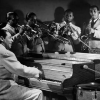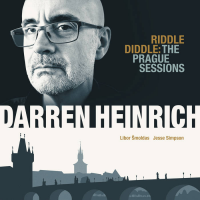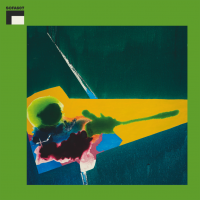Home » Jazz Articles » Album Review » Duke Ellington And His Orchestra: The Treasury Shows Vol. 25
Duke Ellington And His Orchestra: The Treasury Shows Vol. 25
In addition to featuring the last-known Treasury broadcast from the Blue Note Club in Chicago on August 1 1953, this double album contains "bonus" tracks of the band playing at the Hurricane Restaurant in New York City. It is—to be honest—a bit of a rag-bag but there is one track from the Blue Note Club recordings that is an absolute gem.
This is "Duet," featuring Jimmy Hamilton on clarinet and Wendell Marshall on bass. Marshall played with the Ellington band from 1948 to 1955. He was a great, if unheralded, musician who went on to play with just about every major jazz name in the book, most notably as part of a trio led by pianist Hank Jones and featuring the great Kenny "Klook" Clarke on drums. Marshall was also a cousin of the greatest bassist to ever play with Duke, Jimmy Blanton.
"Duet" was usually presented as the second part of a triptych with "Monologue" and "Threesome," "Monologue" being better known as Duke's party piece "Pretty And The Wolf," and "Threesome" appearing in different guises, among them "V.I.P's Boogie" and "Jam With Sam." When Marshall quit the band, "Duet" went with him.
Duke introduces the song here as "a concert-type thing," then elaborates, "In spite of the great difference between these two instruments tonally and technically, they manage to establish an amazing state of unity." Which is true enough.
CD 2 contains a marvellous, happy-go-lucky vocal by Ray Nance on "Jump For Joy" as well as cliché-ridden introductions galore by compere Lee Bennett.
Strangely, the very last track of the Treasury extravaganza is not, repeat not, yet another blast of "Take The A Train," but Irving Berlin's saccharine show tune "Blue Skies" from 1926. The song must have had something. Thelonious Monk would later use its chord sequence as the basis for his composition "In Walked Bud," a tribute to his friend and bebop pioneer Bud Powell. But that—as Lee Bennett would undoubtedly say if he were still around—is another story...
Track Listing
CD 1: Take The A Train; Boo-Dah; What More Can I Say; Frustration; Basin Street Blues; Duet; Ballin’ The Blues; Satin Doll; Moon Mist; You’ll Never Know; Lady Be Good; Tonight I Shall Sleep; Nevada; Subtle Slough; I Don’t Know What Kind Of Blues I Got; Don’t Get Around Much Anymore; Moon Mist. CD 2: At’s In There; Design For Jivin’; Jump For Joy; Solid Old Man; Sentimental Lady; Take The A Train; Now I Know; Perdido; Do Nothin’ Till You Hear From Me; Suddenly It Jumped; Indiana; How Blue The Night; Stomp, Look And Listen; Jumpin’ Frog Jump; Perdido; Do Nothin’ Till You Hear From Me; Blue Skies.
Personnel
Duke Ellington And His Orchestra
band / ensemble / orchestraTaft Jordan, Wallace Jones, Harold Baker, Shelton Hemphill, Clark Terry, Willie Cook, Cat Anderson, Ray Nance, Rex Stewart, Wallace Jones, Harold Baker: trumpet; Joe Nanton, Lawrence Brown, Claude Jones, Quentin Jackson, Britt Woodman, Juan Tizol: trombone; Jimmy Hamilton, Elbert “Skippy” Williams, Russell Procope, Rick Henderson, Johnny Hodges, Otto Hardwick, Nat Jones, Paul Gonsalves, Harry Carney, Ben Webster, Sax Mallard: reeds; Duke Ellington: piano; Fred Guy: guitar; Wendell Marshall, Junior Raglin: bass; Butch Ballard, Sonny Greer: drums; Jimmy Grissom, Al Hibbler, Betty Roché: vocals.
Album information
Title: The Treasury Shows Vol. 25 | Year Released: 2018 | Record Label: Storyville Records
Tags
About Duke Ellington And His Orchestra
Instrument: Band / ensemble / orchestra
PREVIOUS / NEXT
Support All About Jazz
 All About Jazz has been a pillar of jazz since 1995, championing it as an art form and, more importantly, supporting the musicians who make it. Our enduring commitment has made "AAJ" one of the most culturally important websites of its kind, read by hundreds of thousands of fans, musicians and industry figures every month.
All About Jazz has been a pillar of jazz since 1995, championing it as an art form and, more importantly, supporting the musicians who make it. Our enduring commitment has made "AAJ" one of the most culturally important websites of its kind, read by hundreds of thousands of fans, musicians and industry figures every month.



















